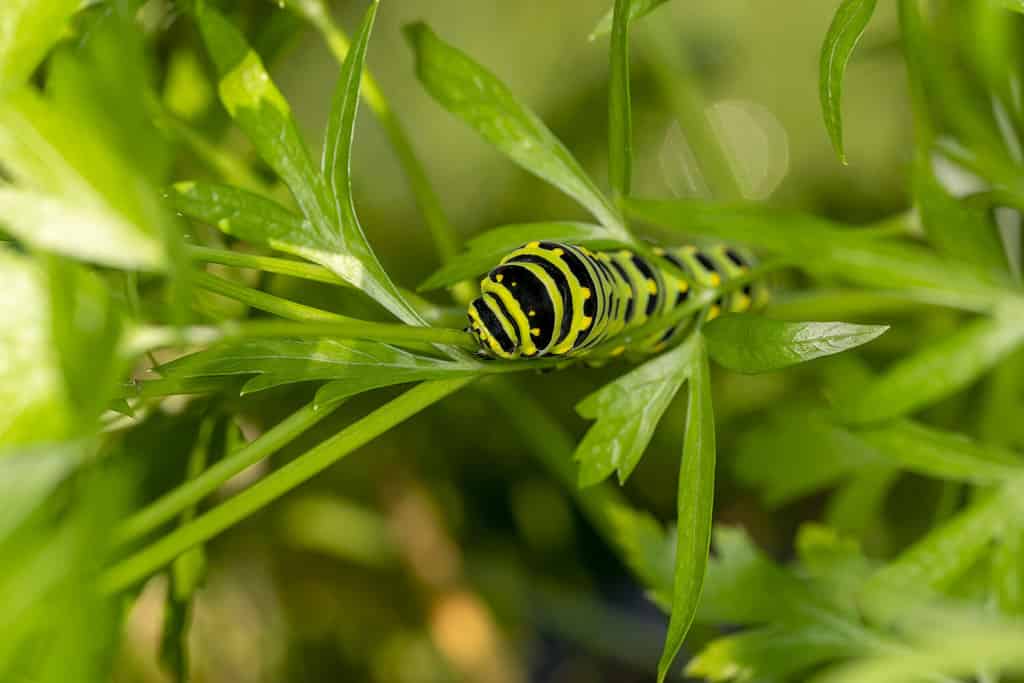
Black Swallowtail caterpillars are a common species in North America. The adult form of the species is the state butterfly of Oklahoma and New Jersey.
©Karel Bock/Shutterstock.com
Caterpillars are beautiful and fascinating creatures that transform into butterflies and moths just as incredible. Although there are hundreds of different types of caterpillars in the state of California, this article will investigate 5 species of particular interest. Be careful though- some of these deceivingly attractive insects are poisonous! Here are 5 caterpillars found in California.

1. Saddleback Caterpillar

The saddleback caterpillar is a species native to North America and Mexico.
©Hagit Berkovich/Shutterstock.com
The saddleback caterpillar, scientifically known as Acharia stimulea, is a unique and striking caterpillar found in North America. Its range in the United States includes areas in California. It derives its name from the prominent saddle-like marking on its back, which resembles a brown or green saddle with a white border. The rest of the caterpillar’s body is covered in vibrant green or yellow color, with additional markings and spines along its sides. The saddleback caterpillar’s appearance may seem captivating, but it conceals a potent defense mechanism. Its spines, which are venomous and capable of delivering a painful sting, serve as a deterrent against potential predators. Contact with these spines can cause severe skin irritation, pain, and even allergic reactions in some individuals. As a result, it is essential to avoid handling or touching these caterpillars in the wild.
Upon completing its larval stage, the saddleback caterpillar undergoes metamorphosis, transforming into an inconspicuous and relatively unremarkable moth. The adult saddleback caterpillar moth is known as the “saddleback slug caterpillar moth”. Unlike the showy appearance of its caterpillar form, the adult moth has a small and relatively plain appearance, with a wingspan of approximately 1 inch. Its wings are a pale brownish color with subtle patterns and markings, allowing it to blend in well with its surroundings. The saddleback caterpillar moth is primarily nocturnal and can often be found flying under the cover of darkness, seeking mates and suitable locations to lay their eggs, thus starting the life cycle anew.
Stings
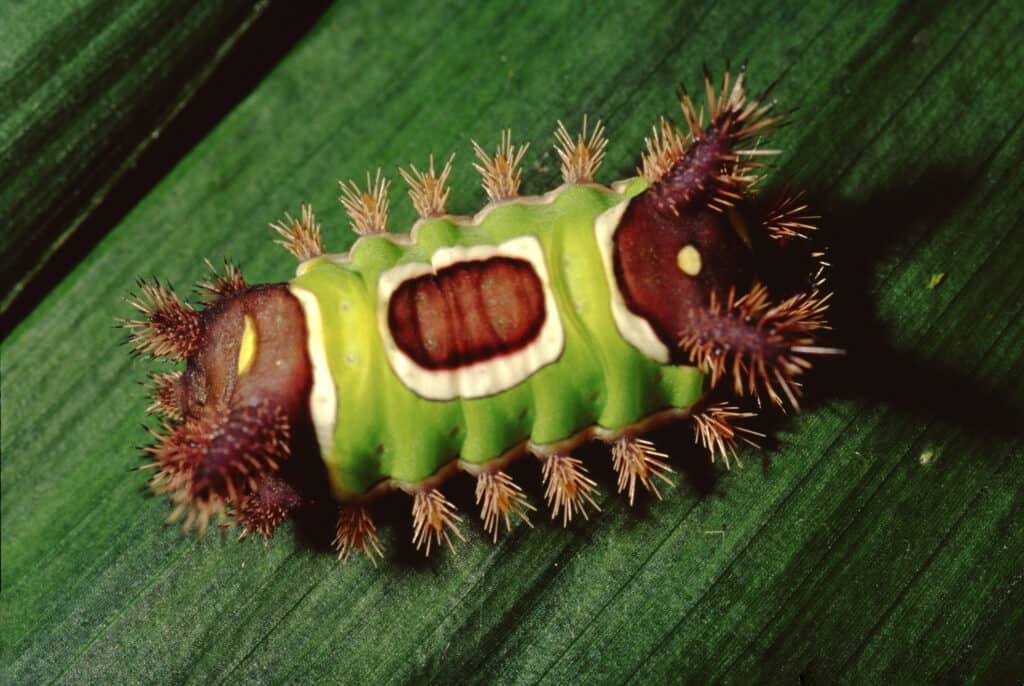
Saddleback caterpillars can deliver a painful sting that has several possible resulting symptoms.
©Liz Weber/Shutterstock.com
A sting from a saddleback caterpillar can result in a painful and potentially serious reaction. The caterpillar’s spines are equipped with venom that can cause intense skin irritation, burning sensations, and sharp pain upon contact. The venom contains irritating substances that can trigger an inflammatory response in the skin, leading to redness, swelling, and even the formation of small blisters at the sting site. In some cases, individuals may also experience symptoms such as headache, nausea, and dizziness, particularly if they are sensitive or allergic to the venom. It is crucial to seek immediate medical attention if stung by a saddleback caterpillar, especially if the reaction is severe or if there is a history of allergies to insect stings. To minimize the risk of encountering these caterpillars, individuals should avoid touching or handling them in the wild, as their spines can easily embed in the skin and release venom.
2. Cabbage Looper Caterpillar
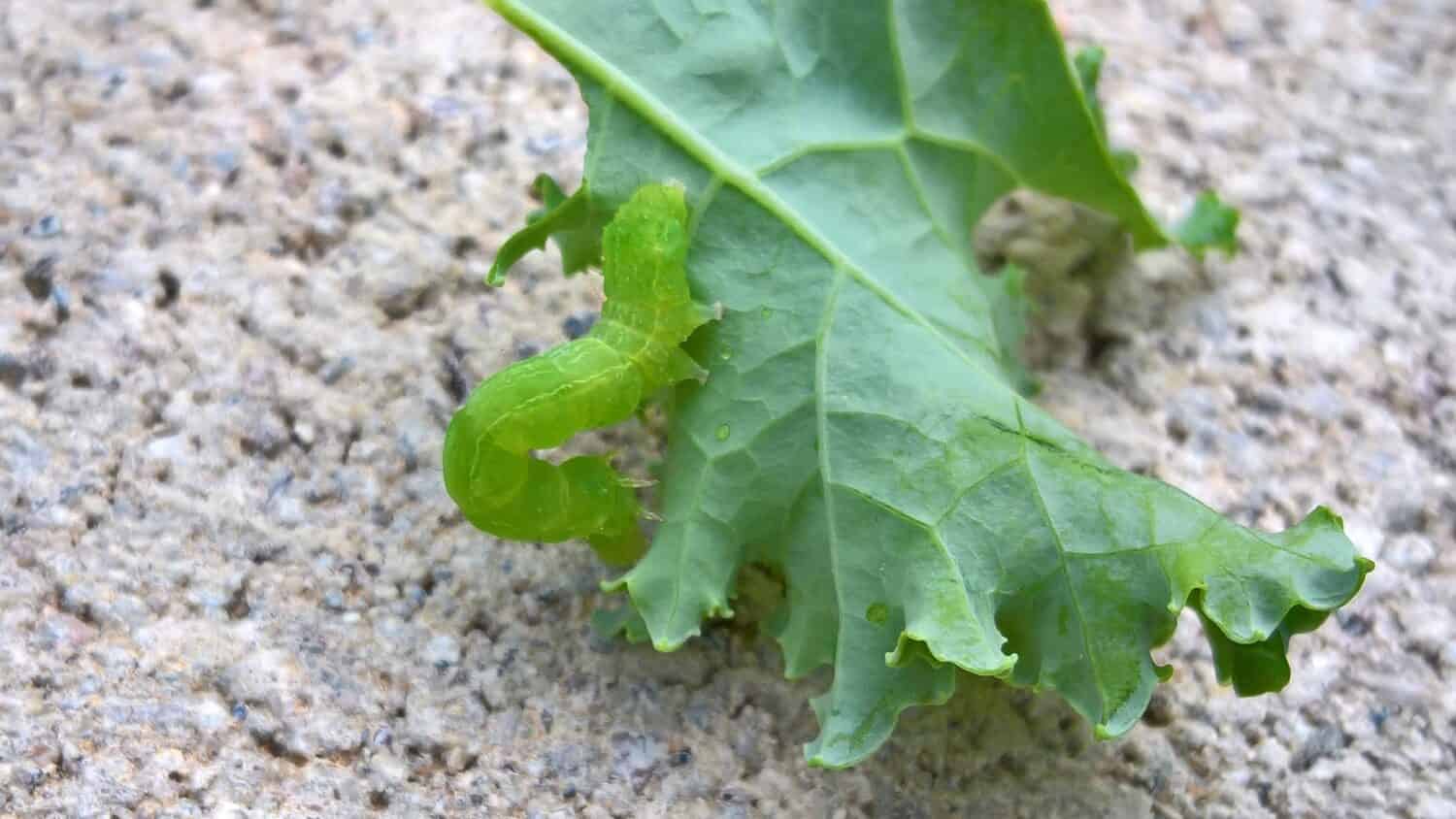
The cabbage looper caterpillar is a bright green color that blends in well with various foliage.
©amy71465/Shutterstock.com
The cabbage looper caterpillar, scientifically known as Trichoplusia ni, is a common and notorious pest found in various regions across North America, including in California. As its name suggests, this caterpillar has a distinctive looping movement when it walks, which sets it apart from other caterpillar species. The cabbage looper caterpillar is typically light green in color, with a narrow white stripe running along its back and sides. Its body is long and slender, and it has three pairs of true legs near its head, as well as prolegs along the rest of its body. These legs enable it to grasp and move efficiently on various surfaces. This voracious feeder primarily targets cruciferous plants, such as cabbage, broccoli, and cauliflower. They often cause considerable damage to crops and vegetable gardens.
After completing its larval stage, the cabbage looper caterpillar undergoes metamorphosis, transforming into a graceful and delicate butterfly. The adult butterfly is the cabbage looper moth or the imported cabbage worm moth. Unlike its caterpillar form, the butterfly exhibits more subdued colors and patterns. The wingspan of the cabbage looper moth can reach up to 1.5 inches, and its wings are a pale grayish-brown with darker markings and faint spots. The cabbage looper moth is primarily nocturnal, and it is often seen flying around fields and gardens during the night, searching for suitable host plants to lay its eggs. The adult moth is not as damaging to crops as its caterpillar counterpart, but its presence can still serve as a warning sign for potential infestations in agricultural settings.
3. Nevada Buck Moth Caterpillar
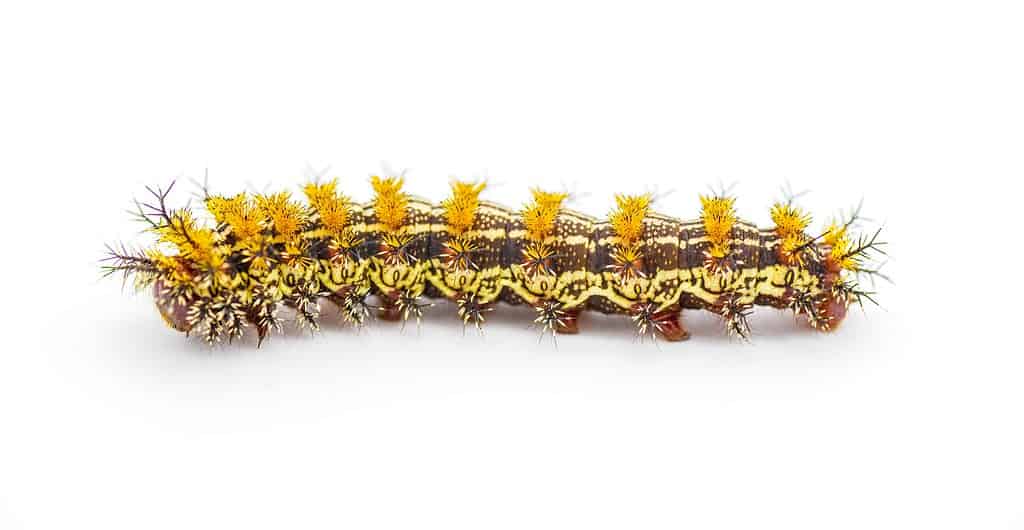
This closely related buck moth species,
Hemileuca maia, has a similar coloration to the Nevada buck moth caterpillar.
©Chase D’animulls/Shutterstock.com
The next caterpillar found in California is the Nevada buck moth caterpillar, scientifically known as Hemileuca nevadensis. This caterpillar sports a remarkable appearance, featuring a black body with orange or reddish-orange stripes running along its sides. On each segment of its body, there are tufts of black bristles, giving it a spiky and intimidating look. These bristles not only add to their unique appearance but also serve as a defensive mechanism, capable of delivering a painful sting if touched. The Nevada buck moth caterpillar primarily feeds on various plant species, mainly those within the Buckwheat family.
Upon completing its larval stage, the Nevada buck moth caterpillar undergoes metamorphosis, transforming into a beautiful and vibrant butterfly. The adult butterfly, also known as the Nevada buck moth, showcases an amazing display of colors and patterns. Its wingspan can range from approximately 2 to 3 inches, featuring a mix of deep reddish-brown, black, and white hues. The wings of the Nevada buck moth exhibit startling eye-like spots. These serve as a form of defense to deter predators. In addition, this butterfly species flies more during the warmer months. They gracefully flutter among their natural habitats of shrublands, grasslands, and open woodlands. The Nevada buck moth adult, like its caterpillar stage, feeds on various plants, contributing to the ecosystem as a crucial pollinator.
Stings
A sting from a Nevada buck moth is often painful and uncomfortable. The bristles that cover the caterpillar’s body can inject venom into the skin upon contact. The venom contains toxins that may cause a range of symptoms, including intense localized pain, redness, swelling, and itching at the sting site. In some cases, individuals may also experience a burning sensation or numbness in the affected area. While the sting is not typically life-threatening, some people may be more sensitive to the venom and may have more severe reactions. It is crucial to seek medical attention if a person exhibits a severe allergic response or if the symptoms persist or worsen.
4. Fall Webworm Caterpillar
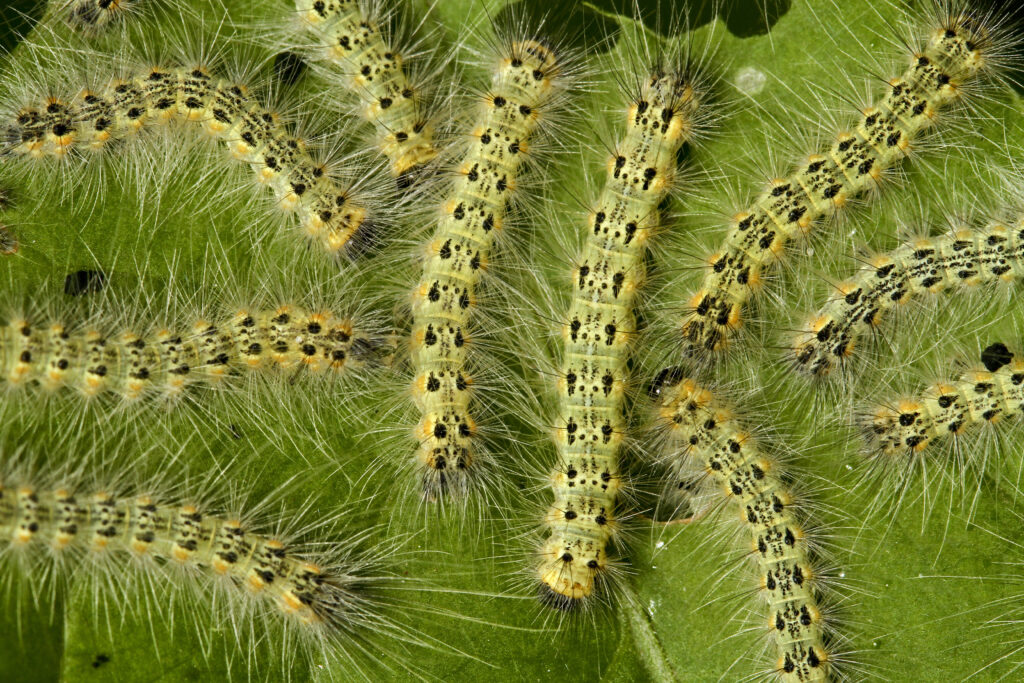
The fall webworm moth caterpillar creates unique webs in the late summer and fall.
©Geza Farkas/Shutterstock.com
The fall webworm caterpillar, scientifically known as Hyphantria cunea, is a common and visually distinctive caterpillar species found in California and several other states. These caterpillars are social creatures. In fact, they often form large communal webs that envelop the foliage of trees. The webs, which can cover entire branches, serve as protective shelters for the caterpillars as they feed on the leaves within. The fall webworm caterpillar has a variable appearance. Some individuals exhibit a white or yellowish color, while others have black spots and stripes on their body. They have long, bristly hairs along their back and sides, and their body sports a dense coat of fine hairs. While fall webworm caterpillars can be pests due to their leaf-eating behavior, they rarely cause significant harm to healthy trees and are an essential food source for various predators and parasitoids.
After completing their feeding and growth phase, fall webworm caterpillars undergo metamorphosis, and emerge as adult moths. The adult fall webworm moth, also known as the white ermine moth, is relatively small, with a wingspan of about 1 to 1.5 inches. The wings of the moth are predominantly white, adorned with black spots and some dark markings. There can be variations in the appearance of the adult moth. For example, some individuals may display more pronounced black markings than others. The white ermine moth is primarily nocturnal, and it can often be seen flying around fields, gardens, and wooded areas during the night. The female moths lay their eggs on the underside of leaves, and the process starts anew as the eggs hatch into new caterpillars, eventually spinning communal webs to feed and grow all over again.
5. Salt Marsh Caterpillar

The salt marsh caterpillar has a black head and a series of alternating longitudinal stripes along its body.
©iStock.com/Liudmyla Lesechko
The salt marsh caterpillar, scientifically known as Estigmene acrea, is a widely distributed species found in California, many other parts of North America, and several areas in South America. The caterpillar has an eye-catching appearance, featuring a black head and a series of alternating longitudinal stripes along its body. These stripes are typically yellow, orange, or reddish in color. The rest of the body, however, has dense tufts of black and white hairs. This gives the species its characteristic furry look. Despite its beauty, the salt marsh caterpillar possesses urticating hairs that can cause skin irritation and discomfort upon contact. This species feeds on a wide range of plants, including various grasses and herbaceous plants. They sometimes live in large numbers, particularly in salt marshes, hence its common name.
Upon completing its larval stage, the salt marsh caterpillar undergoes metamorphosis, transforming into an adult moth. The adult moth of the salt marsh caterpillar is known as the salt marsh moth or the yellow bear moth. Unlike its caterpillar form, the adult moth’s appearance is less colorful and more subdued. It has a pale yellow or cream wingspan of about 1.5 to 2 inches. The wings also have a few black markings and spots. The hindwings are usually a pale white or grayish hue. The salt marsh moth is primarily nocturnal and can often be seen flying around marshy areas and open grasslands during the night. Females lay their eggs in clusters, then the caterpillars emerge to continue the life cycle by feeding and growing on their host plants.
Stings
Handling a salt marsh caterpillar can lead to unpleasant consequences due to its urticating hairs. When touched or handled, these caterpillars can release microscopic, barbed hairs that contain irritating substances. The urticating hairs can cause skin irritation, redness, itching, and a burning sensation in those who encounter them. Some individuals may also experience more severe allergic reactions, with symptoms such as swelling and hives. To avoid these effects, refrain from touching or handling salt marsh caterpillars. Wear protective gloves if necessary when dealing with caterpillars in the wild. If exposed to the caterpillar’s hairs accidentally, thoroughly washing the affected area with soap and water can help. Seeking medical attention may be necessary if a more severe reaction occurs or if the irritation persists.
Summary of 5 Caterpillars Found in California
| Rank | Caterpillar | Poisonous? |
|---|---|---|
| 1 | Saddleback Caterpillar | Yes |
| 2 | Cabbage Looper Caterpillar | No |
| 3 | Nevada Buck Moth Caterpillar | Yes |
| 4 | Fall Webworm Caterpillar | No |
| 5 | Salt Marsh Caterpillar | Yes |
The photo featured at the top of this post is © Gerry Bishop/Shutterstock.com
Thank you for reading! Have some feedback for us? Contact the AZ Animals editorial team.







